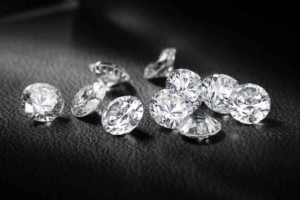How are laboratory-grown diamonds different from natural diamonds?
What are lab-grown diamonds and how are they different from natural diamonds?
Lab-Grown diamonds, also known as synthetic or man-made diamonds, are created in a human-controlled laboratory environment, rather than formed naturally on Earth. Natural diamonds are formed in the lower part of the lithosphere of old platforms (peridotites, eclogites), at a depth of 100-200 km, at very high (900-1300 °C) and pressure (45·108-60·108 Pa). Although lab-grown diamonds are easier and faster to extract, they have exactly the same chemical and physical properties as natural diamonds. You cannot distinguish these diamonds with the naked eye, without special equipment.
Here's how lab-grown diamonds are usually made:
- Currently, the most popular way to grow laboratory diamond is chemical vapor deposition (CVD).
- High pressure high temperature method (HPHT).
Advantages of lab-grown diamonds:
- An ethical choice. Lab-grown diamonds do not raise ethical concerns like some natural diamonds, which can be mined even in active war zones. Also, in order to extract natural stones, they need to be mined, which contributes to environmental pollution and climate change. Meanwhile, synthetic diamonds are produced in a controlled laboratory environment using significantly fewer human and natural resources. A 1 carat laboratory diamond can be grown in just under a month!
- A lab-grown diamond is a very attractive alternative for conscious consumers. Visually, it is exactly the same as natural stone, but can often be twice as cheap. The difference in price is more noticeable when choosing a larger gemstone, because the larger the natural diamond, the rarer and more valuable it is.
- Purity and quality control. Because artificial diamond is grown in a controlled environment, it can be produced with very few impurities and other defects, thus guaranteeing high quality diamonds.
- In the laboratory, diamonds can be grown with any desired characteristics. You can choose the desired size, color and clarity, while the properties of natural diamonds are determined by geological phenomena.
- These synthetic gemstones have a document proving their origin, size, color and purity, each laboratory diamond has a special, exclusive code laser engraved on one of its facets.
- Use in jewelry. Since these stones are physically and chemically the same, no additional knowledge or preparation for inlaying is required. A jeweler who can work with natural diamonds will be able to make a piece with laboratory diamonds without any problems.

A diamond grown in a laboratory
Disadvantages of lab-grown diamonds:
- Value. A synthetic diamond does not hold a high value and is not considered a good investment, unlike a natural diamond. There are predictions that laboratory diamonds may even become cheaper in the future, due to the more accessible technologies used to extract them.
- Uniqueness. Laboratory diamonds are often mass-produced, so they are not as unique as natural diamonds.
- Prestige. Some people want to know that they are wearing a real natural gem that has formed over millions of years, and not a lab or factory made stone.
The use of laboratory diamonds in jewelry
If you like the special brilliance of diamonds, but you don't want to significantly thin your wallet, a professional jeweler will always suggest you to consider laboratory gems instead of natural ones, thus obtaining the maximum ratio of price and appearance of the product. Jewelry is art, and there are no rules in art. It is not uncommon for natural gemstones to be mixed with synthetic lab-grown gemstones in one product. It's not uncommon for engagement ring buyers to want an extra-large center stone, but don't have the budget for it. In this case, the jeweler may recommend choosing a larger, center lab-grown diamond and setting it with smaller, natural gemstones to create a luxurious feel.
Wedding rings with laboratory diamonds are an excellent, economical choice for newlyweds who do not want to spend a large sum on rings, but want an exclusive, more interesting symbol of love.
Engagement rings with laboratory diamonds are perfect for those who want a luxurious, even pompous looking ring. Often, customers choose a stone of 1 carat or even larger, sometimes simply surrounded by gold, and sometimes embellished with other gems.
Bracelets with laboratory diamonds are now a very popular choice, because everyone wants tennis-style bracelets in their wardrobe. A considerable amount of stones are used in this style of bracelet, so natural diamond bracelets are not affordable for everyone. By using laboratory diamonds, you can save up to 50 percent of the product price.
Earrings with laboratory diamonds are a common choice for those looking for earrings. Small, minimalist, close-to-the-ear earrings that can be worn every day.
We invite you for a professional consultation with RG Juvelyrika, we will provide you with all the information about the gems we offer, their types and preliminary prices. We always take into account the wishes of our customers and offer the best possible option. You can find us at Šeškinė st. 32, Vilnius or contact e-mail by post info@rgjuvelyrika.lt and by phone +37064705546 section Contacts.



